Moth
orchids
With increasing popularity,
the moth orchid flaunts its exotic beauty at home gardeners.
The moth orchid —
or Phalaenopsis — is becoming increasingly popular and
it's one of the best orchids for beginners to grow. Take a look
at our guide below to keep your phal blooming happily for months.
TEMPERATURE
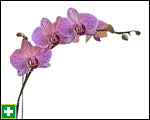 Phalaenopsis
are tropical plants so their first requirement is a warm room. Phalaenopsis
are tropical plants so their first requirement is a warm room.
When in flower, temperatures
should remain above 16 degrees C, although they can endure temperatures
as low as 12 degrees for brief periods. The very occasional fall
to around 10 degrees will not harm your plant, but anything below
this may damage young leaves. An ideal temperature is around 22-24
degrees — moth orchids thrive in consistently warm areas —
although 16-24 degrees is probably more realistic. Higher temperatures,
up to 35 degrees, are tolerated if humidity is not too low. If leaves
turn yellow, it is likely that they have suffered low temperatures.
 To
initiate flower spikes, usually in autumn, a brief period of temperatures
below 16 degrees are necessary. About three weeks of night-time
temperatures at about 11 or 12 degrees will ensure good bud initiation. To
initiate flower spikes, usually in autumn, a brief period of temperatures
below 16 degrees are necessary. About three weeks of night-time
temperatures at about 11 or 12 degrees will ensure good bud initiation.
HUMIDITY
Phals like humidity.
Their succulent leaves store water, and if the air is constantly
dry, this water will evaporate and leaves may wilt. Air conditioning,
dehumidifiers, heaters and even soft furnishing absorb moisture
from the air, effectively lowering the humidity level.
You can increase humidity
by sitting your plant on a saucer of pebbles with water, ensuring
the plant does not touch the water. Misting will also create humidity,
but make sure the plant has time to dry out before nightfall.
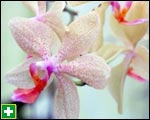 LIGHT LIGHT
Your plant should NOT
be placed in direct sunlight or the leaves will burn. In their natural
habitat, phals grow in the shade of the forest canopy. Too much
light and their dark green leaves may suffer heat damage and begin
to fade. Too little light and the plant may not flower and foliage
may go limp. Warm, humid, circulating air will help keep the leaves
cool. If the light is bright and humidity is low, the leaves may
shrivel.
Place near an east, west or shaded south window.
WATERING
A sure-fire way to kill
your plant is to let it sit in water. The water will crowd out the
air around the roots and suffocate it. On the other hand, you should
not let your plant dry out. Phals grow naturally where the
sun shines in the morning, the rain falls in the afternoon and the
sky clears before sunset. This explains their need for frequent
watering, and because they mostly grow in trees (being, for the
most part, epiphytic), drainage must be good.
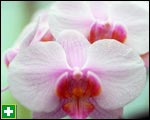 Water
thoroughly under a tap with tepid water, and do so in the morning.
Leave to drain and ensure no water remains on the leaf base, particularly
in cooler weather, or rot may develop. Aerial roots can also be
sprayed to take in water. In cooler weather, you can water less
frequently, although you will still need to ensure your plant does
not dry out. Water
thoroughly under a tap with tepid water, and do so in the morning.
Leave to drain and ensure no water remains on the leaf base, particularly
in cooler weather, or rot may develop. Aerial roots can also be
sprayed to take in water. In cooler weather, you can water less
frequently, although you will still need to ensure your plant does
not dry out.
FEEDING
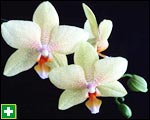 Little
and often is the key to feeding (once a week is good) and a soluble
fertiliser (I use Watkins Bounty fertiliser at half strength), given
at the time of watering, is ideal. Flush the plant thoroughly with
clear water before feeding. There are a number of orchid foods available
on the market that you can use; whichever brand you choose, dilute
and use as specified. Little
and often is the key to feeding (once a week is good) and a soluble
fertiliser (I use Watkins Bounty fertiliser at half strength), given
at the time of watering, is ideal. Flush the plant thoroughly with
clear water before feeding. There are a number of orchid foods available
on the market that you can use; whichever brand you choose, dilute
and use as specified.
Foliar feeding is also
beneficial. If you use this method, dilute about half the strength
used for pot feeding, then mist spray onto the foliage.
Note: Orchids will do
far better with too little fertiliser than with too much.
FLOWERING
 Although
flowers mostly appear in winter and spring, spikes can appear at
any time of the year. It takes about three months from the time
the spike develops to the time it flowers. After flowering, if you
leave the spike, more flowers can develop, although it can look
a bit untidy in the meantime and flowers are generally smaller.
If you cut off the spike just above the second node from the base,
another spike may emerge. However, some believe it best to remove
the spike entirely after its main flowering to allow the plant to
invest its strength in the following year's flowering. Although
flowers mostly appear in winter and spring, spikes can appear at
any time of the year. It takes about three months from the time
the spike develops to the time it flowers. After flowering, if you
leave the spike, more flowers can develop, although it can look
a bit untidy in the meantime and flowers are generally smaller.
If you cut off the spike just above the second node from the base,
another spike may emerge. However, some believe it best to remove
the spike entirely after its main flowering to allow the plant to
invest its strength in the following year's flowering.
REPOTTING
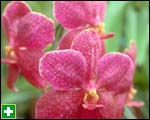 Only
repot when the plant is growing out of its pot. This does not mean
when you see roots at the top of your pot; some roots have a tendency
to wander and do not like being forced back inside. These aerial
roots should be left as is. Only
repot when the plant is growing out of its pot. This does not mean
when you see roots at the top of your pot; some roots have a tendency
to wander and do not like being forced back inside. These aerial
roots should be left as is.
Mature plants may need
the potting medium replaced every two years; gently lift out old
medium and replace with the new material, working it very carefully
around the roots. You must use a free-draining mix. Bark is generally
used, mixed with pumice, sphagnum moss, polystyrene, foam or similar
material.
If you find you do need
a bigger pot, aim for as little root disturbance as possible. The
best time to repot is spring or summer.
PESTS AND DISEASES
Mealy bug and scale can
be controlled with Orthene. Spray outside, early in the day.
Leaf rot is caused when
water is left to sit on the leaves overnight. Cut out any sign of
leaf rot immediately and apply a protective fungicide to ensure
no further spreading.
Jane Wrigglesworth
Reproduced
with permission from NZOOM Home and Garden content,
from the previous
website of 
The views expressed here are not necessarily those of the RNZIH
 |
|
HOME
AND GARDEN |
|
|
More
Garden Articles
|